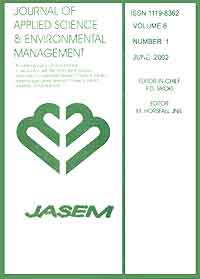
|
Journal of Applied Sciences and Environmental Management
World Bank assisted National Agricultural Research Project (NARP) - University of Port Harcourt
ISSN: 1119-8362
Vol. 22, No. 5, 2018, pp. 719-724
|
 Bioline Code: ja18125
Bioline Code: ja18125
Full paper language: English
Document type: Research Article
Document available free of charge
|
|
|
Journal of Applied Sciences and Environmental Management, Vol. 22, No. 5, 2018, pp. 719-724
| en |
Assessment of Environmental Effects of Post-Blasted Explosive on the Ecosystem of Old Netim Village in Akamkpa Local Government Area of Cross River State, Nigeria
ALABA, OC; ADEBAYO, B & ADESIDA, PA
Abstract
The study investigated the effects of post-blast explosive residues on ecosystems around Prodeco
Quarry industry in Calabar Nigeria by collecting explosives residues and air/fumes samples. The variation between the
intensity and temperature of explosive dissolution in the mine environment shows that TNT appears at the lowest
temperature of 100C and PETN reflected at about 350C and NG shows almost at 580C. Consequently, 5-15 kg of ANFO
produced 10-30 lit/kg of nitrogen oxide compound (NOx) fumes while 20 kg ANFO produced 40 lit/kg of carbon
monoxide fume. Also, 0.2 μg/L concentration of explosive in water recorded the highest mean recovery of 116.0 %
while 1.0 μg/L recorded the highest values of 99.0 %. The mean recovery in soil sample is range between 105.0-126.0 %
while that of forest is range between 91.0-107.0 % with the 50.0 μg/L concentration of explosive. The study concluded
that the contaminating effects of the explosives residues have direct and indirect influences on the growth and development
of the ecosystems.
Keywords
explosive; blasting materials; ecosystems; quarry
|
| |
© Copyright 2018 - Alaba et al.
|
|
